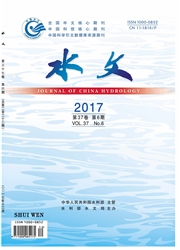

 中文摘要:
中文摘要:
植被和土壤是水循环中的重要载体,模拟流域水循环时植被和土壤的参数化也显得尤为重要。通过对比流域蒸散发模拟中分布式模型和集总式概念模型的土壤植被参数化方法,计算了潘家口水库流域不同时间尺度上的流域蒸散发,分析了不同时间尺度下流域蒸散发的影响因素。通过分析得出:(1)分布式水文模型中的植被参数化方法包括对植被时空分布与变化的描述,以及与之相关的土壤-植被-大气中水分和能量的传输过程的描述。(2)从GBHM模型与流域水热耦合平衡模型的对比分析可知,在流域尺度上,年实际蒸散发与潜在蒸散发之间呈互补的高度非线性关系;但在山坡和小时时间尺度上,实际蒸散发与潜在蒸散发之间呈正比关系,并可近似为线性正比关系。(3)基于流域水热耦合平衡模型在不同时间尺度的参数化分析可知,考虑植被土壤水分和植被覆盖度能改善对流域蒸散发的年际和季节变化的模拟精度;土壤水分和植被的影响随着时间尺度变小表现得越来越显著。
 英文摘要:
英文摘要:
Vegetation and soil are important carriers in water cycles,therefore,soil-vegetation parameterization is importation in catchment hydrological simulation.In this study,the soil-vegetation parameterization schemes in a distributed physically-based hydrological model(GBHM) and the water-energy balance model were discussed to predict actual evapotranspiration in the Luanhe River Basin.Comparison between the physically-based hydrological model and the latter lumped conceptual model can help us understand the dominant control factors on catchment evapotranspiration at different time scales.From the analysis through comparison,it is shown that both simulations of these two models give very close values of annual evapotranspiration and the same complementary relationship between actual and potential evapotranspiration can be found at the annual time scale.The catchment annual evapotranspiration is mainly controlled by the annual precipitation and potential evaporation while the impact of variability of soil water and vegetation become more important at a smaller time scale.It is also known that the relationship between potential and actual evapotranspiration shows a highly nonlinear relationship at the annual and catchment scale,but can be simplified to a linear relationship at hourly temporal and hillslope scales.
 同期刊论文项目
同期刊论文项目
 同项目期刊论文
同项目期刊论文
 Assess the potential of solar irrigation systems for sustaining pasture lands in arid regions &ndash
Assess the potential of solar irrigation systems for sustaining pasture lands in arid regions &ndash Analyzing the Regional Soil-vegetation-atmosphere Interaction Using both the Eagleson and Budyko&rsq
Analyzing the Regional Soil-vegetation-atmosphere Interaction Using both the Eagleson and Budyko&rsq Feasibility analysis of solar irrigation system for pastures conservation in a demonstration area in
Feasibility analysis of solar irrigation system for pastures conservation in a demonstration area in Evaluating the Marginal Land Resources Suitable forDeveloping Pistaciachinensis-Based Biodiesel in C
Evaluating the Marginal Land Resources Suitable forDeveloping Pistaciachinensis-Based Biodiesel in C Analyzing the 2007 drought of Poyang Lake watershed with MODIS-derived normalized difference water d
Analyzing the 2007 drought of Poyang Lake watershed with MODIS-derived normalized difference water d Study of small time scale rainfall amount distribution – a case study on Xiaheyan station, the Yello
Study of small time scale rainfall amount distribution – a case study on Xiaheyan station, the Yello A multistage fuzzy-stochastic programming model for supporting sustainable water-resources allocatio
A multistage fuzzy-stochastic programming model for supporting sustainable water-resources allocatio Agent-based residential water use behavior simulation and policy implications: a case-study in Beiji
Agent-based residential water use behavior simulation and policy implications: a case-study in Beiji Concentrations of selected heavy metals and Arsenic in food from four e-waste disassembly localities
Concentrations of selected heavy metals and Arsenic in food from four e-waste disassembly localities A WebGIS-based system for rainfall-runoff prediction and real-time water resources assessment for Be
A WebGIS-based system for rainfall-runoff prediction and real-time water resources assessment for Be Distributed modeling of land surface water and energy budgets in the inland Haihe river basin of Chi
Distributed modeling of land surface water and energy budgets in the inland Haihe river basin of Chi Necessity and feasibility for an ET-based modern water resources management strategy: a case study o
Necessity and feasibility for an ET-based modern water resources management strategy: a case study o PBBs, PBDEs, and PCBs in foods collected from e-waste disassembly sites and daily intake by local re
PBBs, PBDEs, and PCBs in foods collected from e-waste disassembly sites and daily intake by local re Integrating remote sensing information into a distributed hydrological model for improving water bud
Integrating remote sensing information into a distributed hydrological model for improving water bud Effects of land use change on surface runoff and sediment yield in different scales of watersheds in
Effects of land use change on surface runoff and sediment yield in different scales of watersheds in Amendatory Reversed Distance Square method to interpolate precipitation of long series in large-scal
Amendatory Reversed Distance Square method to interpolate precipitation of long series in large-scal General catchment delineation method and its application into the Middle Route Project of China’s So
General catchment delineation method and its application into the Middle Route Project of China’s So Analysis of effect of South-to-North Water Transfer Project on groundwater exploitation in North Chi
Analysis of effect of South-to-North Water Transfer Project on groundwater exploitation in North Chi Comparison of the Impact of Model Structure on Hydrological Modelling Performance in Different Clima
Comparison of the Impact of Model Structure on Hydrological Modelling Performance in Different Clima Predicting inflows to Barrier Lakes formed in the Wenchuan earthquake using a distributed hydrologic
Predicting inflows to Barrier Lakes formed in the Wenchuan earthquake using a distributed hydrologic Investigation of three-dimensional circulation and hydrography over the Pearl river estuary of China
Investigation of three-dimensional circulation and hydrography over the Pearl river estuary of China An examination of seasonal mean circulation and salinity distributions in the Pearl river estuary of
An examination of seasonal mean circulation and salinity distributions in the Pearl river estuary of Land use and cover change and respond to soil environment change in Jilin province from 1996 to 2005
Land use and cover change and respond to soil environment change in Jilin province from 1996 to 2005 期刊信息
期刊信息
